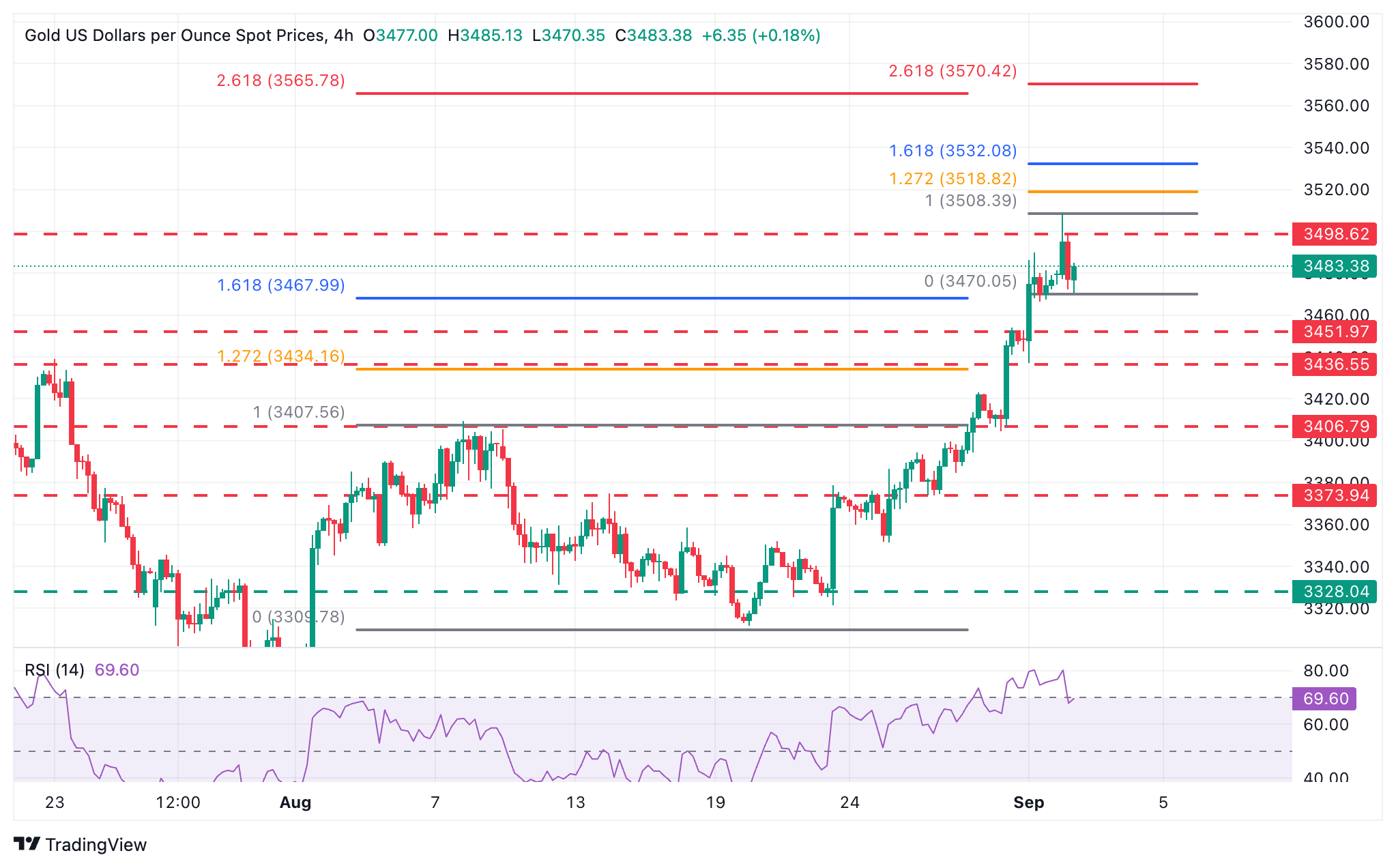Gold Price Forecast: XAU/USD’s reversal from the $3,500 area holds at $3,470
- Gold retreated from fresh record highs beyond $3.500 but remains steady above $3,470.
- The US Dollar appreciates amid higher US yields and a risk-averse market.
- XAU/USD is correcting lower after a six-day rally.
Gold is trading higher for the sixth consecutive day on Tuesday, but the precious metal found sellers at all-time highs right above the $3,500 level, and has given away most of the daily gains, weighed by a strong US Dollar recovery.
The US Dollar Index, which measures the value of the Greenback against the world’s most-traded currencies, appreciates nearly 0.7% on the day. The US Dollar retraces the previous five trading days’ reversal, fuelled by risk aversion and a sharp recovery of US yields, with all eyes on the US manufacturing PMI release.
Technical analysis: Gold is correcting from overbought levels

What goes up must come down at some point, and Bullion’s rally was looking overstretched. The XAU/USD pair had reached overbought levels in practically all time frames after rallying beyond 4% over the last six days and is now correcting lower.
The 4-hour chart shows the Relative Strength Index (RSI) still at the 70 level, which suggests the possibility of a further correction. Immediate support is now at the $3,470 intra-day low ahead of the previous peaks, at $3,450 (July 16 high) and $3435 (Monday’s low and July 23 high).
To the Upside, bulls have a significant challenge at the $3,500 psychological level, where Gold peaked earlier today and on April 22. Further up, the 161.8% retracement of today’s pullback is at $3,530, the 262,8% retracement of that move is coincident with the 262.8% retracement of the early August pullback, at the $3565-$3.570 area.
Gold FAQs
Gold has played a key role in human’s history as it has been widely used as a store of value and medium of exchange. Currently, apart from its shine and usage for jewelry, the precious metal is widely seen as a safe-haven asset, meaning that it is considered a good investment during turbulent times. Gold is also widely seen as a hedge against inflation and against depreciating currencies as it doesn’t rely on any specific issuer or government.
Central banks are the biggest Gold holders. In their aim to support their currencies in turbulent times, central banks tend to diversify their reserves and buy Gold to improve the perceived strength of the economy and the currency. High Gold reserves can be a source of trust for a country’s solvency. Central banks added 1,136 tonnes of Gold worth around $70 billion to their reserves in 2022, according to data from the World Gold Council. This is the highest yearly purchase since records began. Central banks from emerging economies such as China, India and Turkey are quickly increasing their Gold reserves.
Gold has an inverse correlation with the US Dollar and US Treasuries, which are both major reserve and safe-haven assets. When the Dollar depreciates, Gold tends to rise, enabling investors and central banks to diversify their assets in turbulent times. Gold is also inversely correlated with risk assets. A rally in the stock market tends to weaken Gold price, while sell-offs in riskier markets tend to favor the precious metal.
The price can move due to a wide range of factors. Geopolitical instability or fears of a deep recession can quickly make Gold price escalate due to its safe-haven status. As a yield-less asset, Gold tends to rise with lower interest rates, while higher cost of money usually weighs down on the yellow metal. Still, most moves depend on how the US Dollar (USD) behaves as the asset is priced in dollars (XAU/USD). A strong Dollar tends to keep the price of Gold controlled, whereas a weaker Dollar is likely to push Gold prices up.

